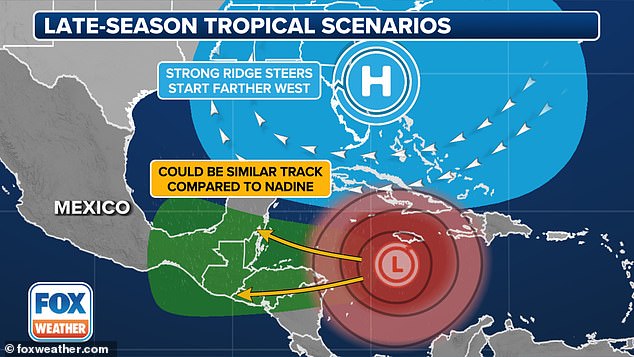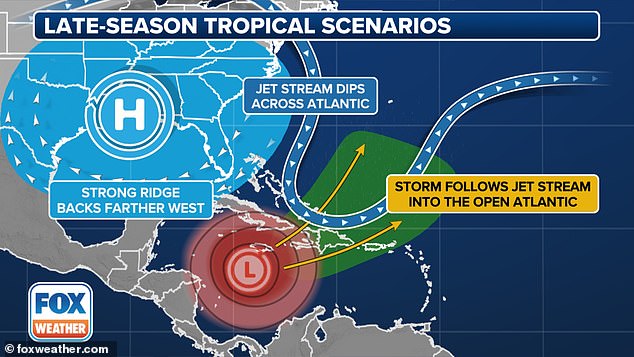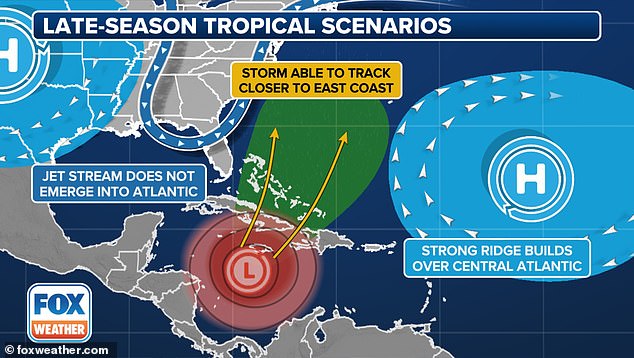Warning for the final month of the hurricane season as forecasts show another storm could hit Florida
Hurricane watchers have issued a warning for the final month of the season after forecasts showed another storm could hit Florida.
The season ends on November 30, but the Atlantic Ocean is still shows signs favorable for cyclones.
Meteorologists predicted that a tropical storm could form in an area of high pressure and push the country onto the same path as Helene and Milton hit Florida earlier this month.
The pressure system could also create a funnel, allowing it to travel along the east coast.
Meteorologist Michael Lowry told us USA today: ‘The storms mentioned that hit us here in the United States in November only occur on average once every fifteen years.
“They don’t happen often, but when they do strike, they almost always hit Florida.”
Although rare, the Sunshine State has experienced three hurricanes in November since 2005, with the most recent in 2022.
Meteorologists warn that there are three possible scenarios that could bring tropical storms and hurricanes to the central Atlantic Ocean from next week through early November
AccuWeather forecasters predict there is a medium chance of a tropical depression or tropical storm developing over the Atlantic Ocean late next week.
As weather experts keep a close eye on Florida, they have identified two other scenarios that would protect the U.S. from future storms.
All three predictions are possible thanks to the Central American Gyre, a large, seasonal area of low pressure that can last for two weeks and cause the formation of tropical storms and hurricanes.
“At the very end of the month we’re going to get this low pressure that looks eerily similar to that Central American Gyre,” FOX Weather meteorologist Steve Bender said.
‘But this one is right in the heart of the Caribbean. So you have all that tropical moisture to tap into.”

The first scenario could bring high pressure, preventing growing storms from reaching the US
Scenario 1: High pressure prevents storms from reaching the US
Forecasters explained that the first possible outcome of a tropical formation would be high pressure that would act as a barricade to protect the US from developing storms.
If strong high pressure, also called wind shear, persists over the southeastern U.S., it could prevent storms from reaching the coast.
Wind shears can block storms by removing heat and moisture from the air, which is necessary for the development of a tropical storm or hurricane.

The second option would force any tropical storms to follow the same path as Oscar and head towards Cuba and the Greater Antilles
Scenario 2: Storm follows the path of Tropical Storm Oscar
The second scenario is similar to the first possibility, with the exception that the high pressure is concentrated over Texas.
If this were to happen, the U.S. would still be protected from any potential tropical storms, but a jet stream over the Atlantic Ocean would force storms east toward Cuba and the Greater Antilles.
This would ultimately be the same path taken by Hurricane Oscar last week, which brought up to 20 inches of rain to the region and caused flash flooding and mudslides.

The latter scenario could bring major storms to Florida, which is still recovering from Hurricanes Helene and Milton.
Scenario 3: High pressure causes storms to reach Florida
The latter scenario would be the worst scenario for the US as high pressure would build over the central Atlantic.
High air pressure develops over the Atlantic Ocean when the air cools enough to allow drier air to escape from the atmosphere.
When this develops over the center of a storm, it removes heat from the air rising through the eye and encourages its growth.
The air is then drawn into the center of the storm, increasing its wind speed and making it a tropical storm once it reaches 63 kilometers per hour.
Winds above 75 miles per hour will result in the storm being upgraded to a hurricane.
The high-pressure ridge, as shown in this scenario, is what sent Hurricane Helene and Milton crashing into the Gulf Coast before reaching the US East Coast.
The Central American Gyre also created an area of low pressure in the western Caribbean – where Helene originated – which combined with the unusually warm atmosphere of the Gulf of Mexico caused the storm to rapidly intensify.
“You’re looking at two high-pressure areas running down the East Coast,” Bender told Fox.
“And as it’s being tracked, you can start to see the impact areas that have already felt tremendous impacts” from Hurricane Helene.
